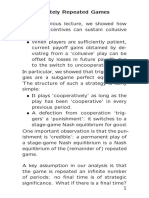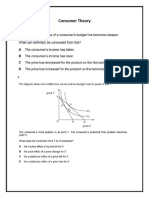Nash Equilibrium: Illustrations
Nash Equilibrium: Illustrations
Uploaded by
August Majer IIICopyright:
Available Formats
Nash Equilibrium: Illustrations
Nash Equilibrium: Illustrations
Uploaded by
August Majer IIIOriginal Description:
Original Title
Copyright
Available Formats
Share this document
Did you find this document useful?
Is this content inappropriate?
Copyright:
Available Formats
Nash Equilibrium: Illustrations
Nash Equilibrium: Illustrations
Uploaded by
August Majer IIICopyright:
Available Formats
Nash Equilibrium:
Illustrations
Cournots Model of Oligopoly
Single good produced by n firms
Cost to firm i of producing q
i
units: C
i
(q
i
), where
C
i
is nonnegative and increasing
If firms total output is Q then market price is
P(Q), where P is nonincreasing
Profit of firm i, as a function of all the firms
outputs:
( ) ( )
q
C
q
P
q q q q
i
i
n
j
j i n
i
|
|
.
|
\
|
=
=1
2 1
..., , ,
t
Cournots Model of Oligopoly
Strategic game:
players: firms
each firms set of actions: set of all possible
outputs
each firms preferences are represented by its
profit
Example: Duopoly
two firms
Inverse demand:
constant unit cost: C
i
(q
i
) = cq
i
, where c < o
Example: Duopoly
Example: Duopoly
Recall for a perfectly competitive firm, P=MC, so
o Q = c, or Q = o c.
Recall for a monopolist, MR=MC, so
o 2Q = c, or Q = (o c)/2.
Example: Duopoly
Example: Duopoly
Best response function is:
Same for firm 2: b
2
(q) = b
1
(q) for all q.
Example: Duopoly
Example: Duopoly
Nash equilibrium:
Pair (q*
1
, q*
2
) of outputs such that each firms action
is a best response to the other firms action
or
q*
1
= b
1
(q*
2
) and q*
2
= b
2
(q*
1
)
Solution:
q
1
= ( o - c - q
2
)/2 and q
2
= (o - c - q
1
)/2
q*
1
= q*
2
= (o - c)/3
Example: Duopoly
Example: Duopoly
Conclusion:
Game has unique Nash equilibrium:
(q*
1
, q*
2
) = (( o - c)/3, (o - c)/3)
At equilibrium, each firms profit is
t = ((o - c)
2
)/9
Total output 2/3(o- c) lies between monopoly
output (o - c)/2 and competitive output o - c.
Cournots Model of Oligopoly
Comparison of Nash equilibrium with collusive
outcomes. Can both firms do better than the
Cournot Nash? Yes! (if they can collude)
Exercise 60.2 in Osborne
Dependence of Nash equilibrium on number of
firms. What happens to the Nash quantity and
price as the number of firms grows?
Exercise 61.1 in Osborne
Bertrands Model of Oligopoly
Strategic variable price rather than output.
Single good produced by n firms
Cost to firm i of producing q
i
units: C
i
(q
i
), where
C
i
is nonnegative and increasing
If price is p, demand is D(p)
Consumers buy from firm with lowest price
Firms produce what is demanded
Bertrands Model of Oligopoly
Strategic game:
players: firms
each firms set of actions: set of all possible prices
each firms preferences are represented by its profit
Example: Duopoly
2 firms
C
i
(q
i
) = cq
i
for i = 1, 2
D(p) = o - p
Example: Duopoly
Nash Equilibrium (p
1
, p
2
) = (c, c)
If each firm charges a price of c then the other firm
can do no better than charge a price of c also (if
it raises its price it sells no output, while if it
lowers its price it makes a loss), so (c, c) is a
Nash equilibrium.
Example: Duopoly
No other pair (p
1
, p
2
) is a Nash equilibrium since
If p
i
< c then the firm whose price is lowest (or
either firm, if the prices are the same) can
increase its profit (to zero) by raising its price to c
If p
i
= c and p
j
> c then firm i is better off
increasing its price slightly
if p
i
p
j
> c then firm i can increase its profit by
lowering p
i
to some price between c and p
j
(e.g. to
slightly below p
j
if D(p
j
) > 0 or to p
m
if D(p
j
) = 0).
Example: Duopoly
45
p
1
p
2
c
c
p
m
p
m
P
2
= BR
2
(p
1
)
P
1
= BR
1
(p
2
)
Hotellings Model of Electoral
Competition
Several candidates run for political office
Each candidate chooses a policy position
Each citizen, who has preferences over policy
positions, votes for one of the candidates
Candidate who obtains the most votes wins.
Hotellings Model of Electoral
Competition
Strategic game:
Players: candidates
Set of actions of each candidate: set of possible
positions
Each candidate gets the votes of all citizens who
prefer her position to the other candidates
positions; each candidate prefers to win than to
tie than to lose.
Note: Citizens are not players in this game.
Example
Two candidates
Set of possible positions is a (one-dimensional)
interval.
Each voter has a single favorite position, on
each side of which her distaste for other
positions increases equally.
Unique median favorite position m among the
voters: the favorite positions of half of the voters
are at most m, and the favorite positions of the
other half of the voters are at least m.
Example
Direct argument for Nash equilibrium
(m, m) is an equilibrium: if either candidate chooses
a different position she loses.
No other pair of positions is a Nash equilibrium:
If one candidate loses then she can do better by
moving to m (where she either wins or ties for first
place)
If the candidates tie (because their positions are
either the same or symmetric about m), then
either candidate can do better by moving to m,
where she wins.
The War of Attrition
Two parties involved in a costly dispute
E.g. two animals fighting over prey
Each animal chooses time at which it intends to
give up
Once an animal has given up, the other obtains
all the prey
If both animals give up at the same time then
they split the prey equally.
Fighting is costly: each animal prefers as short a
fight as possible.
Also a model of bargaining between humans.
The War of Attrition
Strategic game
players: the two parties
each players set of actions is [0,) (set of possible
concession times)
player is preferences are represented by payoff
function
The War of Attrition
If t
1
= t
2
then either player can increase her
payoff by conceding slightly later (in which case
she obtains the object for sure, rather than
getting it with probability 1/2 ).
If 0 < t
i
< t
j
then player i can increase her payoff
by conceding at 0.
If 0 = t
i
< t
j
< v
i
then player i can increase her
payoff (from 0 to almost v
i
- t
j
> 0) by conceding
slightly after t
j
.
The War of Attrition
Thus there is no Nash equilibrium in which
t
1
= t
2
, 0 < t
i
< t
j
, or 0 = t
i
< t
j
< v
i
(for i = 1
and j = 2, or i = 2 and j = 1).
The remaining possibility is that 0 = t
i
< t
j
and t
j
v
i
for i = 1 and j = 2, or i = 2 and j =
1. In this case player is payoff is 0, while if
she concedes later her payoff is negative;
player js payoff is v
j
, her highest possible
payoff in the game.
The War of Attrition
In no equilibrium is there any fight
There is an equilibrium in which either
player concedes first, regardless of the
sizes of the valuations.
Equilibria are asymmetric, even when v
1
=
v
2
, in which case the game is symmetric.
Auctions
Second-Price Sealed-Bid Auction
Assume every bidder knows her own valuation and
every other bidders valuation for the good being
sold
Model
each person decides, before auction begins,
maximum amount she is willing to bid
person who bids most wins
person who wins pays the second highest bid.
Second-Price Sealed-Bid Auction
Strategic game:
players: bidders
set of actions of each player: set of possible bids
(nonnegative numbers)
preferences of player i: represented by a payoff
function that gives player i v
i
- p if she wins
(where v
i
is her valuation and p is the second-
highest bid) and 0 otherwise.
Second-Price Sealed-Bid Auction
Simple (but arbitrary) tie-breaking rule: number
players 1, . . . , n and make the winner the player
with the lowest number among those that submit
the highest bid.
Assume that v
1
> v
2
> > v
n
.
Nash equilibria of second-price sealed-
bid auction
One Nash equilibrium
(b
1
, . . . , b
n
) = (v
1
, . . . , v
n
)
Outcome: player 1 obtains the object at price v
2
;
her payoff is v
1
- v
2
and every other players
payoff is zero.
Nash equilibria of second-price sealed-
bid auction
Reason:
Player 1:
If she changes her bid to some x b
2
the
outcome does not change (remember she pays
the second highest bid)
If she lowers her bid below b
2
she loses and
gets a payoff of 0 (instead of v
1
- b
2
> 0).
Nash equilibria of second-price sealed-
bid auction
Players 2, . . . , n:
If she lowers her bid she still loses
If she raises her bid to x b
1
she still loses
If she raises her bid above b
1
she wins, but
gets a payoff v
i
- v
1
< 0.
Nash equilibria of second-price sealed-
bid auction
Another Nash equilibrium
(v
1
, 0, . . . , 0) is also a Nash equilibrium
Outcome: player 1 obtains the object at price 0;
her payoff is v
1
and every other players payoff is
zero.
Nash equilibria of second-price sealed-
bid auction
Reason:
Player 1:
any change in her bid has no effect on the
outcome
Players 2, . . . , n:
if she raises her bid to x s v
1
she still loses
if she raises her bid above v
1
she wins, but
gets a negative payoff v
i
- v
1
.
Nash equilibria of second-price sealed-
bid auction
For each player i the action v
i
weakly
dominates all her other actions
That is: player i can do no better than bid
v
i
no matter what the other players bid.
Nash equilibria of second-price sealed-
bid auction
b
i
< v
i
b
i
= v
i
b
i
> v
i
I Payoff if
b
^
-i
s b
i
v
i
-
b
^
-i
+
v
i
-
b
^
-i
+
v
i
-
b
^
-i
+
II Payoff if
b
i
< b
^
-i
s v
i
0 v
i
-
b
^
-i
+
v
i
-
b
^
-i
+
III Payoff if
v
i
< b
^
-i
s b
i
0 0 v
i
-
b
^
-i
-
IV Payoff if
b
i
<
b
^
-i
0 0 0
First-Price Sealed-Bid Auction
Strategic game:
players: bidders
actions of each player: set of possible bids
(nonnegative numbers)
preferences of player i: represented by a payoff
function that gives player i v
i
- p if she wins
(where v
i
is her valuation and p is her bid) and 0
otherwise.
Nash Equilibria of First-Price Sealed-Bid
Auction
(b
1
, . . . , b
n
) = (v
2
, v
2
, v
3
, . . . , v
n
) is a Nash
equilibrium
Reason:
If player 1 raises her bid she still wins, but pays a
higher price and hence obtains a lower payoff. If
player 1 lowers her bid then she loses, and
obtains the payoff of 0.
If any other player changes her bid to any price at
most equal to v
2
the outcome does not change. If
she raises her bid above v
2
she wins, but obtains
a negative payoff.
Nash Equilibria of First-Price Sealed-
Bid Auction
Property of all equilibria
In all equilibria the object is obtained by the player
who values it most highly (player 1)
Argument:
If player i 1 obtains the object then we must
have b
i
> b
1
.
But there is no equilibrium in which b
i
> b
1
:
If b
i
> v
2
then is payoff is negative, so she can do
better by reducing her bid to 0
If b
i
v
2
then player 1 can increase her payoff
from 0 to v
1
- b
i
by bidding b
i
.
First-Price Sealed-Bid Auction
As in a second-price auction, any player is
action of bidding b
i
> v
i
is weakly dominated by
the action of bidding v
i
:
If the other players bids are such that player i
loses when she bids b
i
, then it makes no
difference to her whether she bids b
i
or v
i
If the other players bids are such that player i
wins when she bids b
i
, then she gets a
negative payoff bidding b
i
and a payoff of 0
when she bids v
i
First-Price Sealed-Bid Auction
Unlike a second-price auction, a bid b
i
< v
i
of
player i is NOT weakly dominated by any bid.
It is not weakly dominated by a bid b
i
< b
i
Neither by a bid b
i
> b
i
Revenue Equivalence
The price at which the object is sold, and
hence the auctioneers revenue, is the same
in the equilibrium (v
1
, v
2
, . . . , v
n
) of the
second-price auction as it is in the equilibrium
(v
2
, v
2
, v
3
, . . . , v
n
) of the first-price auction.
You might also like
- DLP in Applied Econ - Market StructureDocument5 pagesDLP in Applied Econ - Market StructureHannisch Anne Sakura100% (6)
- Competition Law Moot MemorialDocument19 pagesCompetition Law Moot MemorialTripathi OjNo ratings yet
- Effects of Government InterventionDocument2 pagesEffects of Government InterventionNadeline SupryanataNo ratings yet
- Problem Set 3Document2 pagesProblem Set 3Hoanglucia0% (1)
- Revision NotesDocument20 pagesRevision NotesZ ONo ratings yet
- HW4Monopoly, Game TheoryDocument3 pagesHW4Monopoly, Game TheoryShivani GuptaNo ratings yet
- Keyword AuctionsDocument55 pagesKeyword Auctionsdewip51243No ratings yet
- Auction TheoryDocument37 pagesAuction Theorydewip51243No ratings yet
- Repeated GamesDocument20 pagesRepeated GamesUserNo ratings yet
- B.A. (Hons.) Economics Topics in Microeconmics-I SEM-V (7041) 2013Document7 pagesB.A. (Hons.) Economics Topics in Microeconmics-I SEM-V (7041) 2013gargiNo ratings yet
- Tha 5Document3 pagesTha 5Abhinash BorahNo ratings yet
- Auction Lectures Part 1Document126 pagesAuction Lectures Part 1lockleong93No ratings yet
- Assignment 3Document3 pagesAssignment 3Rohan Lansakara0% (1)
- Game Theory and Its ApplicationsDocument39 pagesGame Theory and Its ApplicationsDwi Supriadi100% (1)
- 06-Extensive Form Perfect IllustrationsDocument13 pages06-Extensive Form Perfect IllustrationsSebastian Torres CordobaNo ratings yet
- PS4AD2019Document3 pagesPS4AD201924msceco08No ratings yet
- Problem2 PDFDocument7 pagesProblem2 PDFLucas PiroulusNo ratings yet
- Final EC3312 2012 - 13Document5 pagesFinal EC3312 2012 - 13bakpengsengNo ratings yet
- IntroGameTheory IIDocument35 pagesIntroGameTheory IIMohd Rafiuddin RoslanNo ratings yet
- Extensive Form GamesDocument22 pagesExtensive Form GamesLeon AshleyNo ratings yet
- ProblemSet1 NewDocument2 pagesProblemSet1 Newsamx9950No ratings yet
- Lecture 6 Auction TheoryDocument36 pagesLecture 6 Auction TheoryBri MinNo ratings yet
- Home 5Document4 pagesHome 5geerthi01No ratings yet
- GT Game 10 17Document32 pagesGT Game 10 17이태호No ratings yet
- Combinatorial Auctions (Document19 pagesCombinatorial Auctions (nq_abcNo ratings yet
- Auction TheoryDocument58 pagesAuction Theory幸村No ratings yet
- Problem Set 1 - TextDocument4 pagesProblem Set 1 - TextMIGUEL ROMERO FNo ratings yet
- Game Theory (S4415) : Answers To Problem Set 4: Prajit K. Dutta June 22, 2001Document5 pagesGame Theory (S4415) : Answers To Problem Set 4: Prajit K. Dutta June 22, 2001Giannis GalanakisNo ratings yet
- Problem Set 4Document2 pagesProblem Set 4HoangluciaNo ratings yet
- GCT 2015-16 - Final Exam - 2015-12-18 - SolutionDocument9 pagesGCT 2015-16 - Final Exam - 2015-12-18 - SolutionpadrefloNo ratings yet
- ECO101 Solved Problems Games and Oligopoly SolutionsDocument10 pagesECO101 Solved Problems Games and Oligopoly Solutionsphineas12345678910ferbNo ratings yet
- Game Theory Exercises 2Document3 pagesGame Theory Exercises 2endu wesenNo ratings yet
- Lecture I-II: Motivation and Decision Theory - Markus M. MÄobiusDocument9 pagesLecture I-II: Motivation and Decision Theory - Markus M. MÄobiuskuchbhirandomNo ratings yet
- Extra ExercisesDocument6 pagesExtra Exercisesb7ng.1119No ratings yet
- Online AuctionsDocument26 pagesOnline Auctionsdewip51243No ratings yet
- Part 4Document31 pagesPart 4MishalBDNo ratings yet
- Introduction To Game Theory (Harvard) PDFDocument167 pagesIntroduction To Game Theory (Harvard) PDFAndresMartinez28No ratings yet
- Problem Set 7Document2 pagesProblem Set 7Luka JanjalashviliNo ratings yet
- Matching With TransfersDocument36 pagesMatching With Transfersdewip51243No ratings yet
- Course in Game TheoryDocument17 pagesCourse in Game TheoryThach Linh TruongNo ratings yet
- Advanced Corporate Finance Problem Set 2 - V3Document5 pagesAdvanced Corporate Finance Problem Set 2 - V3Daisy ZhouNo ratings yet
- Exam 2011Document3 pagesExam 2011Sjef PappersNo ratings yet
- Exercise 4 - QuestionsDocument4 pagesExercise 4 - QuestionsŞimal KöseoğluNo ratings yet
- Oligopoly NumericalsDocument8 pagesOligopoly NumericalsShivi ChaturvediNo ratings yet
- Game Theory Take Home PDFDocument8 pagesGame Theory Take Home PDFDiego MontañaNo ratings yet
- PS 3Document2 pagesPS 3alikberovaadeliaNo ratings yet
- Unit9 F22Document26 pagesUnit9 F22Julia SNo ratings yet
- Normal FormDocument91 pagesNormal FormUday SrivastavaNo ratings yet
- Game Theory Exam QuestionsDocument13 pagesGame Theory Exam QuestionsPaulNo ratings yet
- Final Exam May 2022Document3 pagesFinal Exam May 2022Sheikh Sahil MobinNo ratings yet
- Lecture 7 Price Competition (Bertrand)Document10 pagesLecture 7 Price Competition (Bertrand)Simo SimoNo ratings yet
- Risk Attitudes, Normal-Form Games, Dominance, Iterated DominanceDocument18 pagesRisk Attitudes, Normal-Form Games, Dominance, Iterated DominancegulayagulaNo ratings yet
- Module 3 Game TheoryDocument114 pagesModule 3 Game TheoryAnushka ChokseNo ratings yet
- BITS F314 - Mid Sem - QDocument2 pagesBITS F314 - Mid Sem - Qf20221182No ratings yet
- Options and Their ValuationDocument24 pagesOptions and Their ValuationTiya AmuNo ratings yet
- Lecture 17Document147 pagesLecture 17Giridhar VenkatesanNo ratings yet
- 001 Game Theory - NE ApplicationsDocument31 pages001 Game Theory - NE ApplicationsBabuHalderNo ratings yet
- Chap 1: Normal Form Games: Step 1: Each Player Simultaneously and Independently Chooses An ActionDocument6 pagesChap 1: Normal Form Games: Step 1: Each Player Simultaneously and Independently Chooses An ActionFayçal SinaceurNo ratings yet
- Computer Network Assignment Help: ProblemsDocument7 pagesComputer Network Assignment Help: ProblemsComputer Network Assignment Help100% (1)
- ProblemBank203 2Document86 pagesProblemBank203 2canerNo ratings yet
- Final Exam SolutionsDocument4 pagesFinal Exam SolutionsMajid KhanNo ratings yet
- Trusteer Mobile Risk EngineDocument4 pagesTrusteer Mobile Risk EngineAugust Majer IIINo ratings yet
- Shoulder WorkoutDocument13 pagesShoulder WorkoutAugust Majer IIINo ratings yet
- Relationship Marketing and Brand Involvement of Professionals Through Web-Enhanced Brand Communities: The Case of ColoplastDocument13 pagesRelationship Marketing and Brand Involvement of Professionals Through Web-Enhanced Brand Communities: The Case of ColoplastAugust Majer IIINo ratings yet
- Italian Verbs PDFDocument1 pageItalian Verbs PDFAugust Majer IIINo ratings yet
- Case Study Index Nov 2022Document34 pagesCase Study Index Nov 2022Sonia ShahNo ratings yet
- The Meralco Electric Company Is A Perfect Example ofDocument1 pageThe Meralco Electric Company Is A Perfect Example ofCaren Abulok67% (3)
- Large Number of Buyers and SellersDocument9 pagesLarge Number of Buyers and SellersShreyasi SinhaNo ratings yet
- Biscuit Industry in India-1Document15 pagesBiscuit Industry in India-1Priya BabuNo ratings yet
- Managerial Economics: Monopoly Profit MaximizationDocument13 pagesManagerial Economics: Monopoly Profit MaximizationPrajwalNo ratings yet
- Applied Economics Q3 Module 15Document13 pagesApplied Economics Q3 Module 15trek boi0% (1)
- List of Residential Properties of Panchkula Zone For Auction On Dated 04.08.2022Document3 pagesList of Residential Properties of Panchkula Zone For Auction On Dated 04.08.2022Yogesh MittalNo ratings yet
- Module+9 (BAC+101) MARKET+STRUCTURES Wk+13 18 FinalDocument13 pagesModule+9 (BAC+101) MARKET+STRUCTURES Wk+13 18 FinalalduscraigNo ratings yet
- 150 MCQs Micro A2Document130 pages150 MCQs Micro A2Tooba BawaniNo ratings yet
- Chapter 12 Thomas 13eDocument49 pagesChapter 12 Thomas 13esupisara.pakulNo ratings yet
- Unit IV - (Managerial Economics) Market Structures & Pricing StrategiesDocument37 pagesUnit IV - (Managerial Economics) Market Structures & Pricing StrategiesAbhinav SachdevaNo ratings yet
- MULTIPLE CHOICE. Choose The One Alternative That Best Completes The Statement or Answers The QuestionDocument6 pagesMULTIPLE CHOICE. Choose The One Alternative That Best Completes The Statement or Answers The QuestionMori Gora100% (1)
- Revised Syllabus 2020 2023Document36 pagesRevised Syllabus 2020 2023Subhodeep RoyNo ratings yet
- Economic CSEC Study GuideDocument3 pagesEconomic CSEC Study GuideDannyelle PhillipNo ratings yet
- BBA 1st Sem Syllabus (GU)Document10 pagesBBA 1st Sem Syllabus (GU)Geeta UnivNo ratings yet
- Micro Economics Assignment: Advanced Diploma in Business Management National Institute of Business Management (13.2.2)Document25 pagesMicro Economics Assignment: Advanced Diploma in Business Management National Institute of Business Management (13.2.2)Exelligent Academic SolutionsNo ratings yet
- Chapter One Price and Output Determination Under Monopoly Market StructureDocument49 pagesChapter One Price and Output Determination Under Monopoly Market Structureabadi gebru100% (1)
- Unit 7 Free Response AnswersDocument14 pagesUnit 7 Free Response Answers정서윤No ratings yet
- ECON1001 - Semester 1 - 2022 EssayDocument4 pagesECON1001 - Semester 1 - 2022 EssayStella MoNo ratings yet
- Chapter 17: Oligopoly Principles of Economics, 7 Edition N. Gregory MankiwDocument3 pagesChapter 17: Oligopoly Principles of Economics, 7 Edition N. Gregory MankiwAmalia FebryantiNo ratings yet
- Lesson 3.1 and 3.2 Market StructuresDocument12 pagesLesson 3.1 and 3.2 Market StructuresElisabeth HenangerNo ratings yet
- Steel Industry Overview ReportDocument92 pagesSteel Industry Overview ReportAnkit SinghNo ratings yet
- Market Structure Perfect and Imperfect MarketsDocument31 pagesMarket Structure Perfect and Imperfect MarketsVirat BansalNo ratings yet
- Appliedeconomics12 q1 Mod5 R.olegario-1Document32 pagesAppliedeconomics12 q1 Mod5 R.olegario-1Zhang YixingNo ratings yet
- Conomics: MonopolyDocument31 pagesConomics: MonopolyShuaib IsmailNo ratings yet
- Eco Project Ia 2 Group 07Document30 pagesEco Project Ia 2 Group 07laadla3951No ratings yet
- WK 17 Ch.15-Monopolistic Competition - OKDocument24 pagesWK 17 Ch.15-Monopolistic Competition - OKkassel PlacienteNo ratings yet





























































































